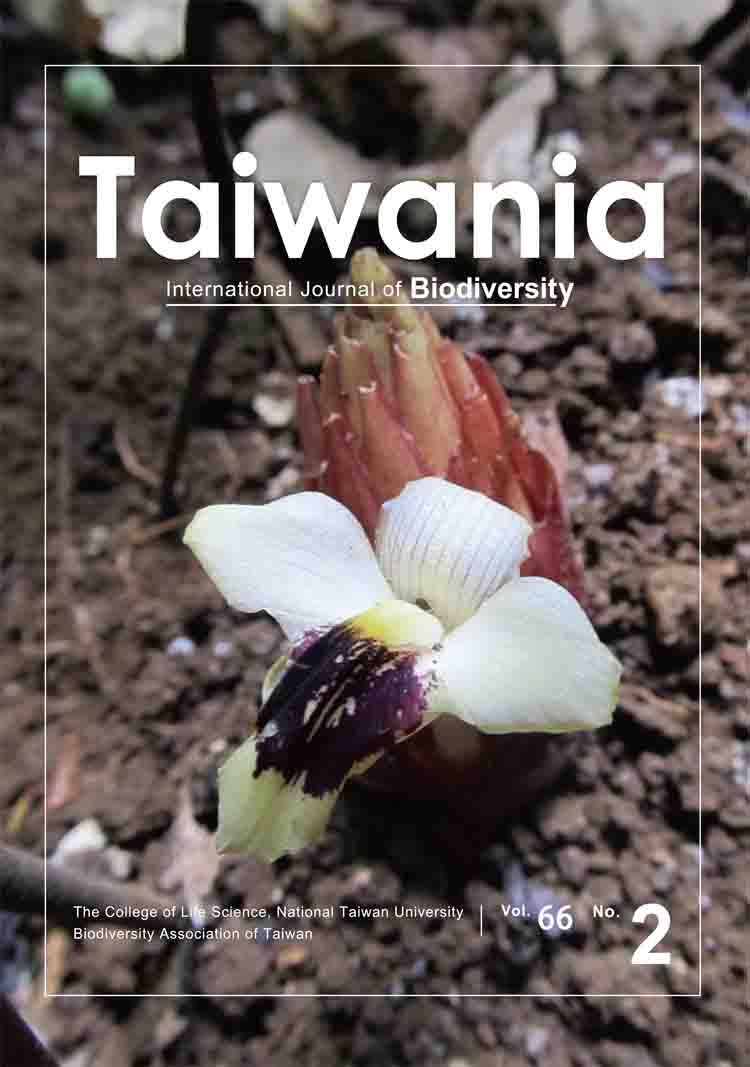Note
Deposition of phasmid eggs (Phasmatodea) in the nests of Acanthomyrmex glabfemoralis Zhou & Zheng, 1997 (Hymenoptera: Formicidae: Myrmicinae)
Aiki Yamada, Joachim Bresseel, Zhilin Chen, Anh D. Nguyen, Katsuyuki Eguchi
Published on: 17 May 2021
Page: 267 - 272
DOI: 10.6165/tai.2021.66.267
Abstract
Ant-mediated secondary dispersal (myrmecochory) of phasmid eggs using a fleshy nutrient-rich appendage called capitulum remains poorly studied, albeit the egg capitula are present in a large number of phasmid species worldwide. We here report our unexpected collection of 42 multi-species phasmid eggs deposited together with seeds in the four nests of the myrmicine ant species, Acanthomyrmex glabfemoralis Zhou & Zheng, 1997, in southern China and northern Vietnam. The collected phasmid eggs were composed of five egg morphospecies that most likely belong to some related genera in the two lonchodid subfamilies, Necrosciinae and Lonchodinae. None of the collected phasmid eggs had an intact capitular structure, indicating a strong likelihood of their consumption by the ants. To our knowledge, these records are the first published field evidence of myrmecochory in the Oriental phasmid species and these two subfamilies, supporting the broad occurrence of the myrmecochory in phasmids. Notes on the seeds deposited in these nests are also provided herewith.
Keyword: Ants, Asia, dispersal, myrmecochory, myrmecophily, stick insects, symbiosis
Literature Cited
Baker, E. 2016. An online taxonomic database of the stick insect (Phasmida) egg-parasitising subfamilies Amiseginae and Loboscelidiinae (Hymenoptera: Chrysididae). Biodivers. Data J. 4: e7441.
DOI: 10.3897/BDJ.4.e7441View Article
Google Scholar
Bolton, B. 2020. AntCat.org: An online catalog of the ants of the world. [Accessed on 9 December 2020]. http://antcat.org/
Bradler, S., J.A. Robertson and M.F. Whiting. 2014. A molecular phylogeny of Phasmatodea with emphasis on Necrosciinae, the most species-rich subfamily of stick insects. Syst. Entomol. 39(2): 205–222.
DOI: 10.1111/syen.12055View Article
Google Scholar
Bragg, P.E. 1995. A new species of Lopaphus Westwood, described from Borneo (Insecta: Phasmida: Heteronemiidae: Necrosciinae). Zool. Meded. Leiden 69(9): 105–111.
Brock, P.D., T. B?scher and E. Baker. 2021. Phasmida Species File Online. Version 5.0/5.0. [Accessed on 14 January 2021]. http://Phasmida.SpeciesFile.org
Clark-Sellick, J.T. 1997. Descriptive terminology of the phasmid egg capsule, with an extended key to the phasmid genera based on egg structure. Syst. Entomol. 22(3): 97–122.
DOI: 10.1046/j.1365-3113.1997.d01-30.xView Article
Google Scholar
Clark-Sellick, J.T. 1998. The micropylar plate of the eggs of Phasmida, with a survey of the range of plate form within the order. Syst. Entomol. 23(2): 203–228.
DOI: 10.1046/j.1365-3113.1998.00056.xView Article
Google Scholar
Compton, S.G. and A.B. Ware. 1991. Ants disperse the elaiosome-bearing eggs of an African stick insect. Psyche (Camb. Mass.) 98(2-3): 207–214.
DOI: 10.1155/1991/18258View Article
Google Scholar
Eguchi, K., T.V. Bui and Sk. Yamane. 2004. A preliminary study on foraging distance and nesting sites of ants in Indo-Chinese lowland vegetation. Sociobiology 43(3): 445–457
Eguchi, K., T.V. Bui and S. Yamane. 2008. Vietnamese species of the genus Acanthomyrmex Emery, 1893 - A. humilis sp. n. and A. glabfemoralis Zhou & Zheng, 1997 (Hymenoptera: Formicidae: Myrmicinae). Myrmecol. News 11: 231–241.
Goldberg, J., J. Bresseel, J. Constant, B. Kneub?hler, F. Leubner, P. Michalik and S. Bradler. 2015. Extreme convergence in egg-laying strategy across insect orders. Sci. Rep. 5(1): 7825.
DOI: 10.1038/srep07825View Article
Google Scholar
H?lldobler, B. and E.O. Wilson. 1990. The Ants, Springer, Berlin, 732 pp.
Hisasue, Y. and T. Mita. 2020. Rhadinoscelidia lixa sp. nov. (Hymenoptera, Chrysididae, Loboscelidiinae) found on an ant nest in Thailand. ZooKeys 975: 1–9.
DOI: 10.3897/zookeys.975.54952View Article
Google Scholar
Hughes, L. and M. Westoby. 1992. Capitula on stick insect eggs and elaiosomes on seeds: convergent adaptations for burial by ants. Funct. Ecol. 6(6): 642–648.
DOI: 10.2307/2389958View Article
Google Scholar
Ito, F., B. Gobin and R. Hashim. 2017. Harvesting fig seeds from bird feces by an Oriental myrmicine ant species, Acanthomyrmex ferox Emery, 1893 (Hymenoptera: Formicidae). Asian Myrmecol. 9: e009017.
Kimsey, L.S. 2012. Review of the odd chrysidid genus Loboscelidia Westwood, 1874 (Hymenoptera, Chrysididae, Loboscelidiinae). ZooKeys 213: 1–40.
DOI: 10.3897/zookeys.213.2985View Article
Google Scholar
Moffett, M.W. 1985. Behavioral notes on the Asiatic harvesting ants Acanthomyrmex notabilis and A. ferox. Psyche (Camb. Mass.) 92(2–3): 165–179.
DOI: 10.1155/1985/53040View Article
Google Scholar
Ness, J., K. Mooney and L. Lach. 2010. Ants as mutualists. In: Lach, L., C.L. Parr and K.L. Abbott (eds.), Ant Ecology: 97–114. Oxford University Press, New York.
O'Hanlon, J.C., B.R. Jones and M.W. Bulbert. 2020. The dynamic eggs of the Phasmatodea and their apparent convergence with plants. Sci. Nat. 107(4): 1–12.
Riek, E.F. 1970. Loboscelidiidae. In: The Insects of Australia: 910. CSIRO, Melbourne University Press, Melbourne.
Robertson, J.A., S. Bradler and M.F. Whiting. 2018. Evolution of oviposition techniques in stick and leaf insects (Phasmatodea). Front. Ecol. Evol. 6: 216.
DOI: 10.3389/fevo.2018.00216View Article
Google Scholar
Stanton, A., D. Dias and J.C. O'Hanlon. 2015. Egg dispersal in the Phasmatodea: convergence in chemical signaling strategies between plants and animals? J. Chem. Ecol. 41(8): 689–695.
DOI: 10.1007/s10886-015-0604-8View Article
Google Scholar
Windsor, D.M., D.W. Trapnell and G. Amat. 1996. The egg capitulum of a neotropical walking stick, Calynda bicuspis, induces aboveground egg dispersal by the ponerine ant, Ectatomma ruidum. J. Insect Behav. 9(3): 353–367.
DOI: 10.1007/BF02214015View Article
Google Scholar
Yamada, A., F. Ito, R. Hashim and K. Eguchi. 2018. Queen polymorphism in Acanthomyrmex careoscrobis Moffett, 1986 in Peninsular Malaysia (Hymenoptera: Formicidae: Myrmicinae), with descriptions of hitherto unknown female castes and males. Asian Myrmecol. 10: e010009.


